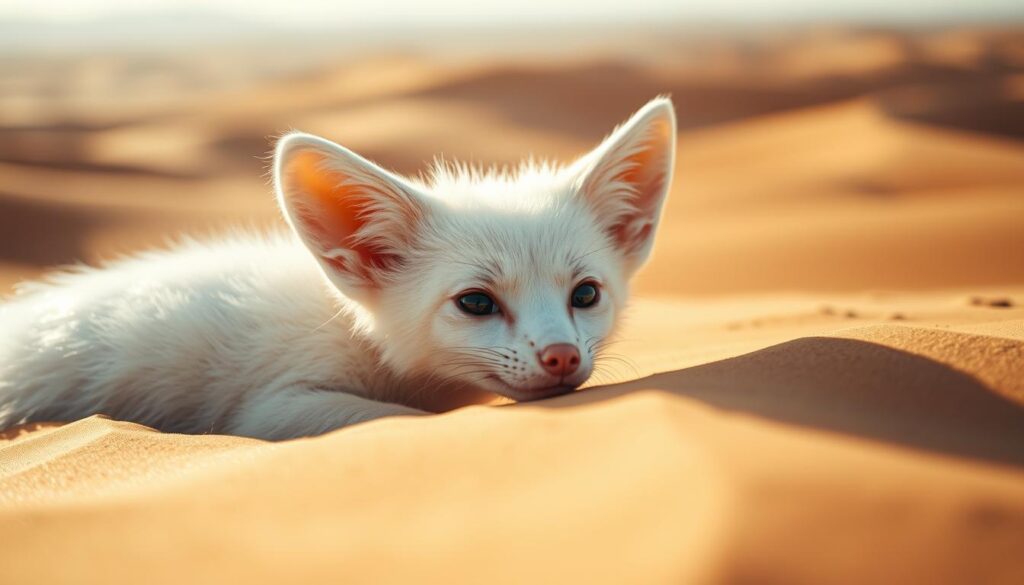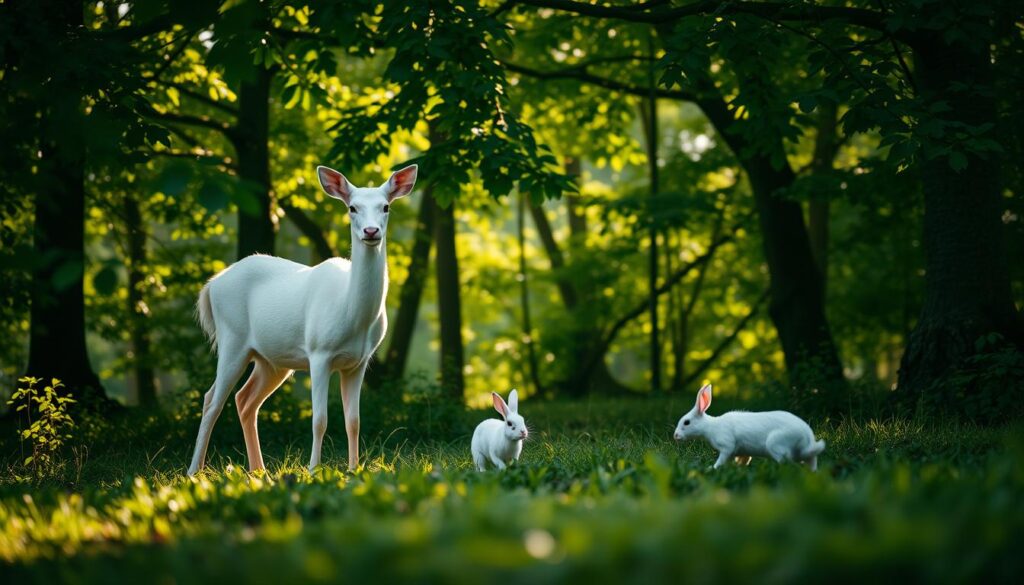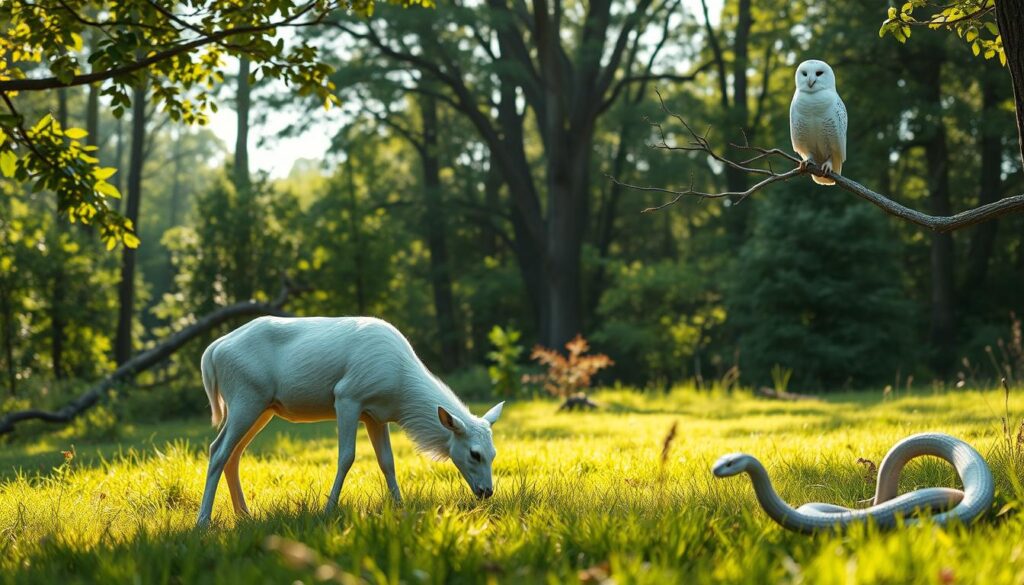Albino animals are rare and capture our imagination with their unique look. They are a key area of study in wildlife conservation. Their rarity makes them even more interesting to explore.

The world of albino animals is full of surprises. They have unusual coloring and adapt well to their environments. We will learn about their challenges and what makes them special. Protecting these animals and their homes is crucial for their survival.
Introduction to Albino Animals
Albino animals are vital to our ecosystem, keeping nature in balance. By studying them, we understand the importance of wildlife conservation. The study of albino animals is captivating for scientists and animal lovers.
Key Takeaways
- Albino animals are a rare phenomenon in the natural world
- These rare animal species play a vital role in maintaining the balance of nature
- Wildlife conservation efforts are essential to protect albino animals and their habitats
- Albino animals face unique challenges in the wild, including predation and competition for resources
- The study of albino animals is a fascinating field that continues to capture the imagination of scientists and animal lovers alike
- Albino animals are an important part of the ecosystem, and their conservation is crucial for maintaining biodiversity
Understanding Albinism in Wildlife
Albinism is a rare genetic condition that affects animals. It causes a lack of pigmentation in their skin, hair, and eyes. To understand albinism in wildlife, we need to look at the albinism causes and how they impact different species. The condition is caused by genetic factors, including mutations in genes responsible for melanin production.
There are several types of albinism, each with its own characteristics. Ocular albinism affects the eyes, while cutaneous albinism affects the skin. The genetic factors behind albinism are complex, involving multiple genes to produce melanin.
Some key factors that contribute to albinism in animals include:
- Genetic mutations: Changes in the DNA sequence of genes responsible for melanin production can lead to albinism.
- Inheritance: Albinism can be inherited from parents, and the risk of passing on the condition depends on the type of albinism and the genetic makeup of the parents.
- Environmental factors: Exposure to certain environmental toxins or chemicals can increase the risk of genetic mutations that lead to albinism.
By understanding the albinism causes and types of albinism, we can better appreciate the complexities of this condition. The genetic factors involved in albinism are crucial to understanding how the condition is inherited. They also show how it affects different species.
The Remarkable Features of Albino Animals in the Wild
Albino animals have unique characteristics that make them stand out. They lack pigmentation, appearing white or pale. This can be both a blessing and a curse, as it makes them more visible to predators but also more noticeable to observers.
Some albino animal features include poor eyesight, increased sensitivity to sunlight, and a higher risk of skin cancer. Yet, these animals have developed unique characteristics to adapt to their environment. For instance, albino deer are more cautious and elusive than their non-albino counterparts.
Observations of albino animals in their natural habitats offer valuable insights. By studying these animals, researchers can better understand the effects of albinism on their survival and interactions with their environment.
The study of albino animal features and unique characteristics gives us a fascinating look into the natural world’s diversity and complexity. By continuing to explore and learn about these remarkable animals, we can deepen our appreciation for nature’s beauty and wonder.
Survival Challenges Faced by White Wildlife
Albino animals in the wild face many survival challenges. One big issue is avoiding predators. Their lack of camouflage makes them easy to spot. This means they must find other ways to stay safe.
Another big problem is being sensitive to the sun. Albino animals have less melanin, which makes them more vulnerable to sunlight. This can hurt their eyes and make it hard for them to hunt and live in their environment.
- Predator avoidance difficulties due to lack of camouflage
- Sun sensitivity issues that can cause discomfort and pain
- Hunting and feeding challenges that impact their ability to survive
Despite these challenges, albino animals are incredibly resilient. They have developed special ways to deal with their environment and overcome obstacles.
Most Common Albino Animals Found in Nature
Albino animals are rare and fascinating in nature. They come in many forms, like albino mammals, birds, and reptiles. Despite challenges, many albino animals adapt and thrive.
Albino birds stand out with their white feathers and pink eyes. Examples include pigeons, sparrows, and eagles. Albino reptiles include snakes, turtles, and alligators.
Here are some common albino animals:
- Albino mammals: white deer, albino squirrels, and rare albino bears
- Albino birds: pigeons, sparrows, eagles, and owls
- Albino reptiles: snakes, turtles, alligators, and crocodiles
These creatures are found worldwide. Their unique traits are a wonder to see. By studying albino mammals, albino birds, and albino reptiles, we appreciate nature’s diversity and complexity.
The Truth About Albino Animal Population Statistics
Albino animals are very rare in the wild. It’s estimated that only a few per million have albinism. The rate of albinism varies among different species, with some being more likely to have it.
Genetics and environmental factors affect the frequency of albinism in animals. Environmental factors like chemicals or radiation can increase the chance of albinism. Here’s a table showing the estimated frequency of albinism in different animal groups:
| Animal Group | Estimated Frequency of Albinism |
|---|---|
| Mammals | 1 in 100,000 |
| Birds | 1 in 1,000 |
| Reptiles and Amphibians | 1 in 500 |
Knowing the stats on albino animals is key for conservation and research. By looking at wildlife statistics, we can learn about the factors that affect albinism. This helps us protect these special animals.
Albino animals face big challenges in the wild. They have trouble avoiding predators and adapting to their environments. So, it’s important to focus on protecting albino animals to keep wildlife diverse.
How Albino Animals Adapt to Survive
Albino animals have special adaptation strategies to live in the wild. These strategies help them survive in places where their lack of color would be a problem. By learning about these animals, we can understand how species and their environments interact.
One important way albino animals survive is through defense mechanisms. For instance, some roll in mud or dust to hide their lack of color. Others become aggressive to scare off predators. These defense mechanisms are key to their survival and often work together with other adaptation strategies.

Albino animals also show unique social behavior. Some form close bonds with other animals for protection and support. For example, albino birds may stay with one mate for life to care for their young and defend their territory. These social behavior patterns are vital for albino animals and are shaped by their environment and other species.
- Behavioral adaptations, such as changes in activity patterns or habitat use
- Natural defense mechanisms, such as camouflage or aggressive behavior
- Social behavior, such as forming close bonds with other animals
By studying the adaptation strategies, defense mechanisms, and social behavior of albino animals, we can learn more about species and their environments. This knowledge helps us protect these unique and fascinating creatures.
Famous Cases of Albino Animals Around the World
Many famous albino animals have caught the world’s eye. Their rare condition has sparked both wonder and a need for conservation. Migaloo, the albino humpback whale, is a prime example. He was seen in Australian waters in 1993.
Other famous ones include Snowflake, the albino gorilla from Equatorial Guinea, born in 1966. He later lived in a Spanish zoo. Alba, the albino alligator, also stands out. She lives in a US wildlife sanctuary. These animals serve as symbols for their species, showing the need to protect their homes.
- An albino lion named Kibo, who was born in a zoo in Germany
- An albino kangaroo named Onyx, who resides in a wildlife sanctuary in Australia
- An albino python named Ophelia, who is part of a conservation breeding program in the United States
These animals have touched many hearts. They inspire us to care more about conservation and our planet’s well-being.
Conservation Efforts for Protecting Albino Wildlife
Albino animals are rare and fascinating. They face many challenges to survive. Conservation efforts are key to protect them. Sanctuary programs offer a safe place for them to live.
These programs are run by dedicated groups. They rescue and help albino animals. Supporting protection laws and natural habitats helps albino wildlife survive. Some notable efforts include:
- Research studies on albino animals to understand their behavior and needs
- Community outreach and education to raise awareness about conservation
- Collaborations with governments and other organizations for effective conservation efforts
Together, we can help albino animals and preserve our planet’s beauty. Sanctuary programs and protection laws ensure their survival. Our efforts will have a lasting impact on wildlife conservation.
The Role of Albinism in Different Ecosystems
Albinism is key in many ecosystems, shaping biodiversity and nature’s balance. Albino animals face special challenges and chances in different places. For example, in forests, they struggle to hide from predators because they lack color.
In water, however, albinos might have an edge. Their lack of color makes them harder to spot by predators. The albinism role is vital in guiding animal behavior and survival in these environments. It also impacts biodiversity by changing species populations and ecosystem health.
Some important points about albinism in ecosystems are: * It can change how animals act together, making them more or less social. * Albino animals can add genetic variety to a species, passing on unique traits. * Places with lots of different species are more likely to have albinos, thanks to varied habitats and resources.

In summary, albinism’s role in ecosystems is complex and far-reaching. More study is needed to grasp its full effect on biodiversity and nature’s balance. By exploring the albinism role in various ecosystems, we can better appreciate the need to protect these delicate systems.
Myths and Misconceptions About Albino Animals
Albino animals have long been surrounded by myths and misconceptions. Many believe they are cursed or supernatural. But, albinism is just a genetic condition that affects melanin production. This results in no pigmentation in skin, hair, and eyes.
Cultural beliefs have fueled these myths and misconceptions. In some cultures, albino animals are sacred or mystical. In others, they are seen as omens of bad luck. It’s important to separate fact from fiction and learn the scientific facts about albinism.
Common Misconceptions
- Albino animals are not more aggressive than their non-albino counterparts.
- Albinism is not a disease, but rather a genetic condition.
- Albino animals are not more prone to health problems than non-albino animals.
By understanding and addressing these myths and misconceptions, we can promote a more accurate view of albino animals. Cultural beliefs and scientific facts can both be true. Exploring their intersection helps us appreciate the natural world more.
Impact of Climate Change on Albino Species
Climate change is deeply affecting our planet, impacting many species in different ways. Albino species are especially vulnerable because of their unique traits. These traits make them more susceptible to climate change’s effects.
The rising temperatures and changed ecosystems from climate change are altering the homes of albino species. For example, the melting of polar ice caps is harming albino polar bears. Also, the changing sea temperatures are affecting albino marine species.
- Loss of habitat and food sources
- Increased predation due to changed ecosystems
- Disrupted migration patterns
We must tackle the environmental impact of climate change to protect albino species and others. By cutting down our carbon footprint and supporting green practices, we can lessen climate change‘s effects. This will help keep these unique creatures safe.
Conclusion: Embracing Nature’s Unique White Wonders
As we wrap up our journey into the world of albino animals, it’s clear they are true wonders of nature. Their unique look and survival challenges have captured our hearts. They remind us of the incredible variety in our ecosystems.
We’ve discovered how albinism affects these animals, their special features, and how they survive. We’ve also seen why conservation efforts are key to protecting these rare species.
Looking ahead, it’s vital we keep valuing and protecting albino animals‘ habitats. By cherishing their beauty and understanding their role in nature, we help them thrive. This way, they can continue to amaze us for years to come.
Nature is always fascinating, from rare albino animals to mysterious deep-sea creatures
FAQ
What is the cause of albinism in animals?
Albinism in animals comes from a genetic mutation. This mutation affects how melanin, the color pigment, is made. Without enough melanin, animals appear white or pale.
What are the different types of albinism found in animals?
Animals can have different types of albinism. These include complete, partial, and ocular albinism. The type depends on the genetic factors and how much melanin is made.
How do albino animals adapt to survive in the wild?
Albino animals have special ways to survive. They are more sensitive to light and sound. They also have natural defenses and unique social behaviors to hide and avoid predators.
What are some of the challenges faced by albino animals in the wild?
Albino animals face many challenges. They are easy prey because they can’t hide. They also struggle with sunlight and finding food because of their vision problems.
What are some of the most common albino animals found in nature?
You can find albino animals like white tigers, deer, and squirrels. Birds like white peacocks and crows are also common. Reptiles and amphibians, such as white snakes and frogs, are seen too.
How rare are albino animals in the wild?
Albino animals are quite rare. Only about 1 in 20,000 animals are completely albino. Their rarity is due to genetics, environment, and evolution.
What conservation efforts are in place to protect albino wildlife?
Many efforts protect albino wildlife. There are sanctuaries, research, and laws. These help raise awareness and ensure albino animals can live in their natural habitats.
How does climate change impact albino species?
Climate change affects albino species a lot. Changes in the environment make it hard for them to adapt and survive. Things like temperature changes, losing habitats, and more UV radiation are big challenges.
What are some common myths and misconceptions about albino animals?
Many myths surround albino animals. Some think they are supernatural or have special powers. Others believe they are a different species or get sick easily. It’s important to know the truth about albinism in wildlife.
